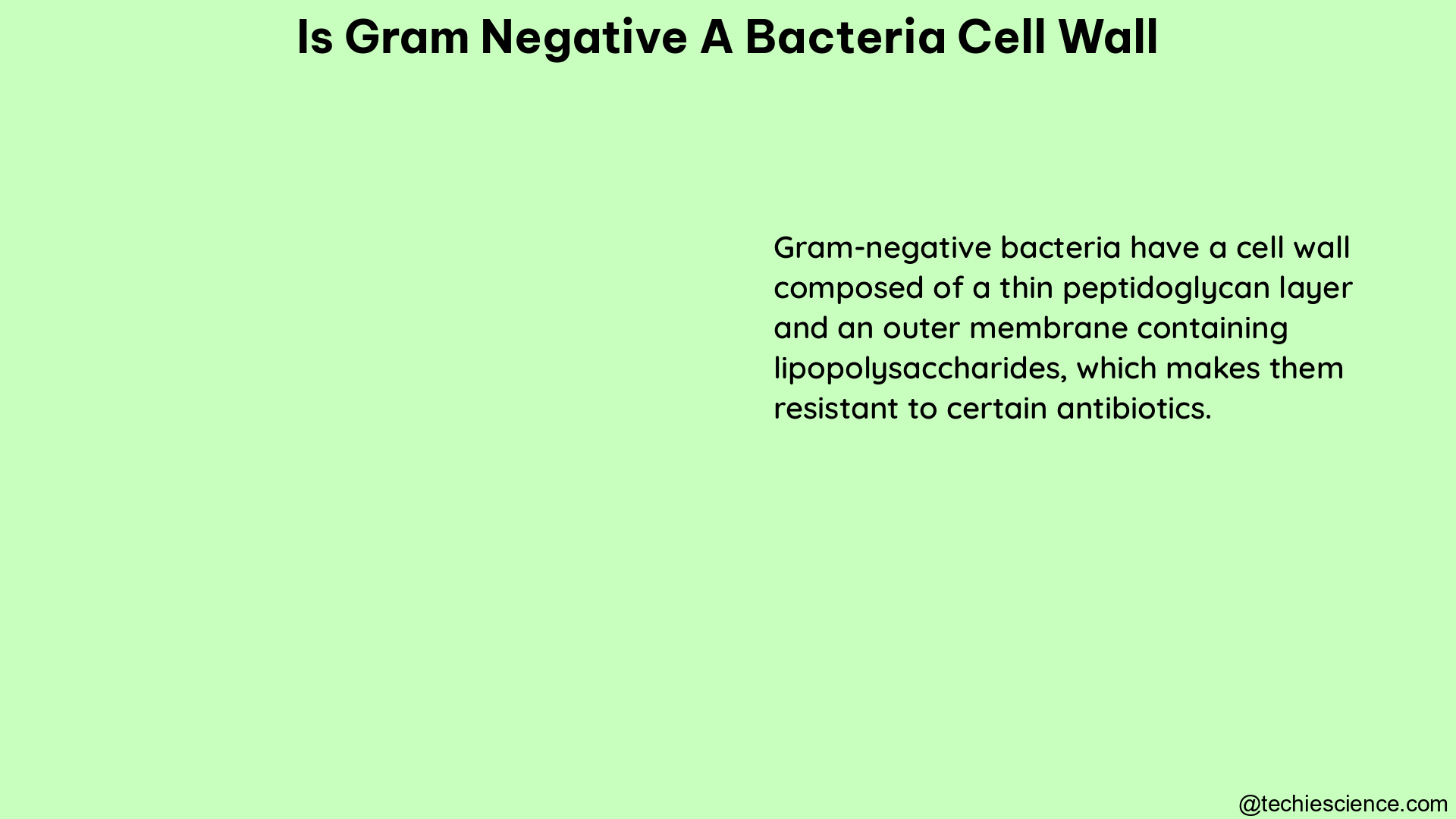Gram-negative bacteria possess a unique and complex cell wall structure that sets them apart from their Gram-positive counterparts. This intricate cell wall plays a crucial role in the survival, pathogenicity, and interaction of these microorganisms with their environment. In this comprehensive guide, we will delve into the intricacies of the Gram-negative bacterial cell wall, exploring its composition, structure, and the advanced techniques used to study its properties.
The Multilayered Structure of Gram-Negative Cell Wall
The Gram-negative cell wall is a multilayered structure that consists of an outer membrane, a thin peptidoglycan layer, and a periplasmic space between the outer membrane and the inner plasma membrane. This complex architecture provides Gram-negative bacteria with enhanced protection, selective permeability, and the ability to withstand various environmental stresses.
Outer Membrane
The outer membrane of Gram-negative bacteria is a unique and essential component of their cell wall. It is composed of lipopolysaccharides (LPS), phospholipids, and proteins, and it is responsible for the characteristic negative charge on the cell surface. The LPS molecules in the outer membrane are made up of a hydrophobic lipid A component and a hydrophilic polysaccharide chain, which contribute to the overall structural and functional properties of the cell wall.
The lipid A component of LPS is particularly noteworthy, as it is the primary cause of the endotoxic activity of Gram-negative bacteria. When released during cell lysis or infection, lipid A can trigger a severe inflammatory response in the host, leading to conditions such as fever, septic shock, and even death.
Peptidoglycan Layer
The peptidoglycan layer in Gram-negative bacteria is relatively thin, typically only a few nanometers thick, and is located adjacent to the inner plasma membrane. This layer is composed of glycan strands cross-linked by peptide bridges, providing the cell wall with strength and rigidity. Despite its thinness, the peptidoglycan layer plays a crucial role in maintaining the structural integrity of the cell and protecting it from osmotic lysis.
Periplasmic Space
The periplasmic space, situated between the outer membrane and the inner plasma membrane, is a unique feature of Gram-negative bacteria. This space contains a variety of enzymes and transport proteins that are involved in various cellular processes, such as nutrient uptake, waste excretion, and cell wall biosynthesis. The periplasmic space serves as a compartment for these essential functions, contributing to the overall efficiency and adaptability of Gram-negative bacteria.
Quantifying the Cell Wall Properties

Researchers have developed advanced techniques to study the properties of the Gram-negative cell wall, including its surface charge density, which is a critical characteristic that influences the cell’s interactions with its environment.
Second Harmonic Generation Spectroscopy (SHS)
One such technique is Second Harmonic Generation Spectroscopy (SHS), which is a direct, sensitive, and accurate method for detecting the number of molecular ions adsorbed as counter charges on the exterior bacterial surface. This technique can provide a measure of the surface charge density, which is a crucial parameter in understanding the interfacial physiology of the cell.
In a study using SHS, the negative charge density of the lipopolysaccharide-coated outer surface of the Gram-negative bacterium Escherichia coli was found to be 6.6 ± 1.3 nm. This information is valuable in understanding the interactions between Gram-negative bacteria and their surrounding environment, as well as the potential implications for antimicrobial strategies and bioremediation applications.
Adaptability and Resilience of Gram-Negative Cell Wall
The cell wall of Gram-negative bacteria is not only complex in structure but also highly adaptable and resilient. It is capable of withstanding high turgor pressure, extreme temperatures, and a wide range of pH levels. Additionally, the cell wall can expand several times its normal surface area, demonstrating its remarkable flexibility and ability to accommodate changes in the bacterial environment.
This adaptability and resilience are crucial for the survival and proliferation of Gram-negative bacteria in diverse ecological niches, from the human gut to industrial settings. Understanding the mechanisms behind these properties can provide valuable insights into the persistence and pathogenicity of Gram-negative microorganisms, as well as inform the development of more effective antimicrobial strategies.
Conclusion
The Gram-negative bacterial cell wall is a remarkable and intricate structure that plays a pivotal role in the survival, pathogenicity, and interaction of these microorganisms with their environment. By delving into the details of its multilayered composition, advanced characterization techniques, and remarkable adaptability, we can gain a deeper understanding of the unique features that make Gram-negative bacteria such successful and resilient organisms. This knowledge can inform the development of innovative strategies for combating Gram-negative infections, as well as the design of novel biotechnological applications that leverage the unique properties of this fascinating cell wall structure.
References:
- Wilhelm, M. J., Sharifian, G. M., Wu, T., Li, Y., Chang, C.-M., & Dai, H.-L. (2021). Determination of bacterial surface charge density via saturation of adsorbed ions. Biointerphases, 16(2), 02D501.
- Beveridge, T. J. (2003). Structures of Gram-Negative Cell Walls and Their Derived Membrane Vesicles. Microbiology and Molecular Biology Reviews, 67(2), 229–260.
- Duquenoy, A., Bellais, S., Gasc, C., Schwintner, C., Dore, J., & Thomas, V. (2020). Assessment of Gram- and Viability-Staining Methods for Quantifying Bacterial Community Dynamics Using Flow Cytometry. Journal of Microbiological Methods, 179, 105923.

Hello, I am Bhairavi Rathod, I have completed my Master’s in Biotechnology and qualified ICAR NET 2021 in Agricultural Biotechnology. My area of specialization is Integrated Biotechnology. I have the experience to teach and write very complex things in a simple way for learners.